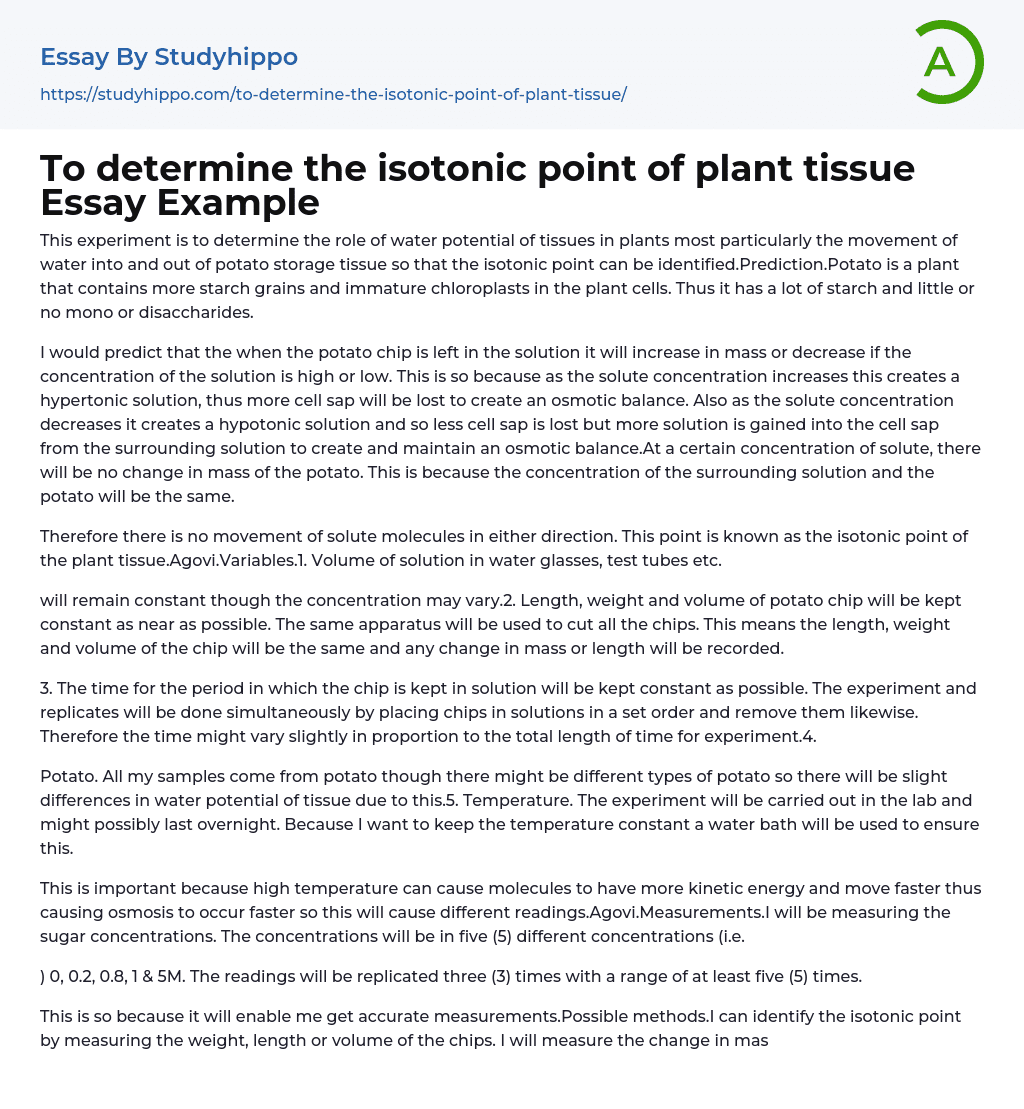This experiment is to determine the role of water potential of tissues in plants most particularly the movement of water into and out of potato storage tissue so that the isotonic point can be identified.Prediction.Potato is a plant that contains more starch grains and immature chloroplasts in the plant cells. Thus it has a lot of starch and little or no mono or disaccharides.
I would predict that the when the potato chip is left in the solution it will increase in mass or decrease if the concentration of the solution is high or low. This is so because as the solute concentration increases this creates a hypertonic solution, thus more cell sap will be lost to create an osmotic balance. Also as the solute concentration decreases it creates a hypotonic solution and so less cell sap is los
...t but more solution is gained into the cell sap from the surrounding solution to create and maintain an osmotic balance.At a certain concentration of solute, there will be no change in mass of the potato. This is because the concentration of the surrounding solution and the potato will be the same.
Therefore there is no movement of solute molecules in either direction. This point is known as the isotonic point of the plant tissue.Agovi.Variables.1. Volume of solution in water glasses, test tubes etc.
will remain constant though the concentration may vary.2. Length, weight and volume of potato chip will be kept constant as near as possible. The same apparatus will be used to cut all the chips. This means the length, weight and volume of the chip will be the same and any change in mas
or length will be recorded.
3. The time for the period in which the chip is kept in solution will be kept constant as possible. The experiment and replicates will be done simultaneously by placing chips in solutions in a set order and remove them likewise. Therefore the time might vary slightly in proportion to the total length of time for experiment.4.
Potato. All my samples come from potato though there might be different types of potato so there will be slight differences in water potential of tissue due to this.5. Temperature. The experiment will be carried out in the lab and might possibly last overnight. Because I want to keep the temperature constant a water bath will be used to ensure this.
This is important because high temperature can cause molecules to have more kinetic energy and move faster thus causing osmosis to occur faster so this will cause different readings.Agovi.Measurements.I will be measuring the sugar concentrations. The concentrations will be in five (5) different concentrations (i.e.
) 0, 0.2, 0.8, 1 & 5M. The readings will be replicated three (3) times with a range of at least five (5) times.
This is so because it will enable me get accurate measurements.Possible methods.I can identify the isotonic point by measuring the weight, length or volume of the chips. I will measure the change in mass as its quite accurate since change in length or volume is not because the cell wall is rigid being made out of cellulose and thus will allow the cell to expand or contract to a limited extent.Method.1.
Label 3 watch glasses each with 0, 0.2, 0.8, 1 & 5M. Using a
measuring cylinder measure and make serial dilutions of sucrose.2. Using a 50ml syringe measure 50ml of the 5M sucrose solution to each of the three watch glasses labelled 5M.
3. Repeat the second stage for all the other concentrations of sucrose solution. You can use either a different syringe for each solution or rinse out and clean the syringe between each solution.4. Prepare the cylinders of potato using the cork borer and then cut the 18 cylinders to about 5cm in length using a scalpel. Measure each cylinder and record the length of each individual cylinder and keep them in the same order.
5. Dry each cylinder with a blotting paper and weigh it using a top pan balance. Record the weight with the corresponding length.6.
Place one potato cylinder into each watch glass starting with the most concentrated sucrose solution to the least concentrated. Ensure that you have recorded which cylinder is in which watch glass.7. Note the time and leave for approximately 3hours.
8. Remove the cylinders from the watch glass in the same order in which they were placed, then carefully blot each cylinder reweigh and remeasure each cylinder taking care to ensure that the results are matched with the initial values.9. Calculate the change in mass per gram for each concentration and then the average change in mass per gram in order to allow accurate comparisons. You can then plot a graph of the average change in mass per gram against the sucrose concentration.
- Tree essays
- Seed essays
- Acid essays
- Calcium essays
- Carbohydrate essays
- Carbon essays
- Chemical Bond essays
- Chemical Reaction essays
- Chemical reactions essays
- Chromatography essays
- Concentration essays
- Copper essays
- Diffusion essays
- Ethanol essays
- Hydrogen essays
- Organic Chemistry essays
- Osmosis essays
- Periodic Table essays
- Ph essays
- Salt essays
- Sodium essays
- Titration essays
- Bacteria essays
- Biotechnology essays
- Breeding essays
- Cell essays
- Cell Membrane essays
- Cystic Fibrosis essays
- Enzyme essays
- Human essays
- Microbiology essays
- Natural Selection essays
- Photosynthesis essays
- Plant essays
- Protein essays
- Stem Cell essays
- Viruses essays




